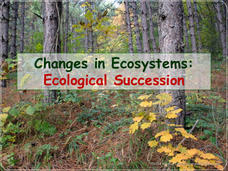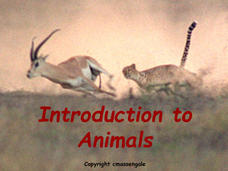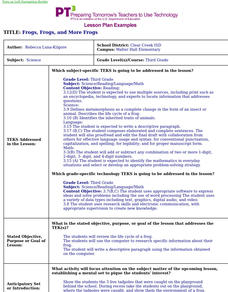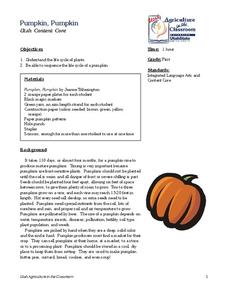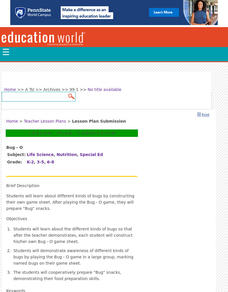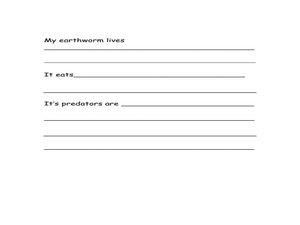Curated OER
Pop-Up Wildlife Mural
Pupils research life in a rainforest including plants, animals, insects, climate. They discover reasons for the importance of rainforests to the Earth's environment. Students work as a group to create a large 3-D rainforest scene that...
Biology Junction
Changes in Ecosystems: Ecological Succession
Can an area with no soil turn into a forest? Scholars learn about the process of ecological succession using an interesting presentation. It covers both primary and secondary succession in the building of new ecosystems.
American Museum of Natural History
Bio-Benefits
Kick-start a discussion of the importance of biodiversity with a colorful resource that touts the benefits of maintaining healthy ecosystems. The images stress the interdependence of all the elements of an ecosystem.
Biology Junction
Introduction to Animals
Out of all animals, elephants alone lack the ability to jump. Scholars learn all about animals using a presentation full of fun examples. It describes different types of animals, the biological similarities and differences between...
Curated OER
Invertebrates
Students identify insect body parts and look for local insect life. They create an insect using recycled material and design a classroom mural with bug facts. They study Monarch butterflies and dragonflies.
Curated OER
What's A Mammal?
Students examine mammals understanding what a mammal is and reviewing the eleven mammal groups. In this science lesson, students play a game known as Mystery Mammal Game. Yet, first students research about the mammal and then give...
Curated OER
Frogs, Frogs, And More Frogs
Third graders review the life cycle of a frog. They use the computer to research specific information about their frog and write a descriptive paragraph using the information obtained on the computer. They access websites imbedded in...
Curated OER
The Birth of a Butterfly
Students explore the life cycle of a butterfly. In this butterfly lesson, students visit Internet websites, observe a live butterfly culture, and examine pictures of the stages of the butterfly life cycle in order to independently...
Curated OER
Flour Beetles
Learners observe life stages in flour beetles and graph the results. They write a summary report.
Curated OER
Pumpkin Patch
Students create a pumpkin art project that outlines the life cycle of a pumpkin in order to learn the growth process of this particular vegetable. In this pumpkin art lesson plan, students first review the life cycle of a pumpkin as a...
Curated OER
Pumpkin, Pumpkin
First graders understand that pumpkins grow slowly over several months. In this pumpkin instructional activity, 1st graders listen to the book Pumpkin, Pumpkin and recall the sequence of the pumpkin life cycle. Students create pumpkin...
Curated OER
Larva and Adult Antlion Body Parts
Students identify the major body segments of antlions. Through the use of diagram worksheets, students label the various body parts of the antlion. They review the life cycle of antlions from the larva stage to adult. Several activities...
Curated OER
So You Think You're Tough
Fourth graders learn how to classify animals. In this invertebrates lesson, 4th graders discuss how we classify thinks into groups and move into a discussion about classifying animals. Students learn about the differences between...
Curated OER
Biodiversity
Students investigate the diversity of temperate forests and tropical rainforests. They catch and observe local insects, sort leaves and insects on a chart, listen to the book "A Walk in the Rainforest," and create a class bar graph that...
Curated OER
Goldilocks and the Real Bears
Students participate in a comparison lesson where they compare fictional bears to real life bears. In this science/language arts lesson, students read Goldilocks and the Three Bears. Students observe characteristics of these fictional...
Curated OER
Food Labels
Students study Nutrition Facts labels. In this life science activity, students explore Nutrition Facts labels, then determine and analyze the nutrients found in a variety of foods. Additionally students construct bug boxes used to...
Curated OER
Butterfly Lifecycles
What a great way to present this topic! While a little difficult to follow, this lesson plan provides great ideas for a second grade lesson plan involving butterfly lifecycles. Learners make drawings of butterflies, discuss life cycles,...
Curated OER
Bug-O
Middle school special education students (moderate to severe) learn about insects by playing an entomological version of bingo. They cut out pictures of different bugs and glue them onto a grid. Place the game card inside a sheet...
Curated OER
Inviting Butterflies to the Schoolyard
Students create a butterfly garden. In this butterfly garden lesson, students plot a garden with plant species that will attract butterflies. Students learn about the specific plants and items that will help butterflies use the garden.
Curated OER
Animals Around the World
Students study different kinds of animals and what group they belong to. In this animal classification lesson students view different animals and sort them by what group they belong to, for example a snake is in the reptile group.
Curated OER
Bugs in the Woods
Second graders identify insects and plants in the forest ecosystem in a structured field trip with stations and activity booklets. In this bugs instructional activity, 2nd graders explore the ecosystem of the forest, complete the...
Curated OER
Body Parts of a Butterfly
Students identify the seven major parts of a butterfly. In this butterfly anatomy lesson, students explore three dimensional models of butterflies and discuss the anatomy. Students view a PowerPoint for the anatomical parts of a...
Curated OER
Taking a Micro Hike
Students investigate organisms by searching soil on their school ground. In this insect life lesson, students utilize field guides to help identify the organisms found in a rotting log on their campus. Students photograph any insects...
Curated OER
Earthworms and Making a Wormery
Students explore the environment by researching insects. In this earthworm lesson, students utilize soil and plexiglass to build a see through wormery in which students can observe the worms at work. Students identify the benefits of...



